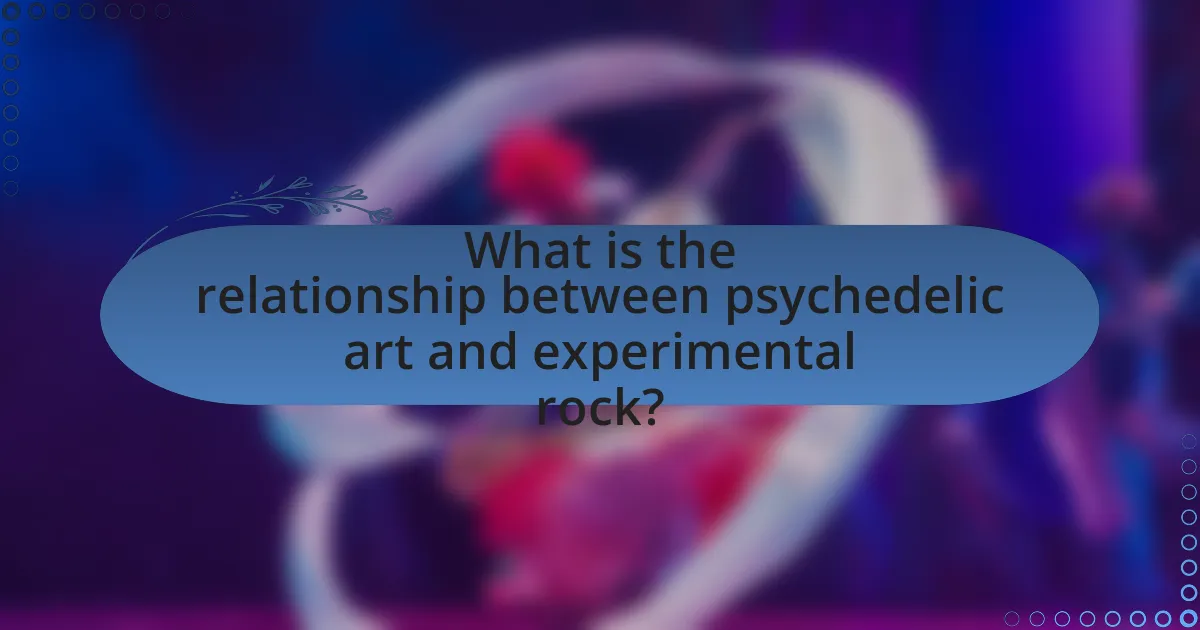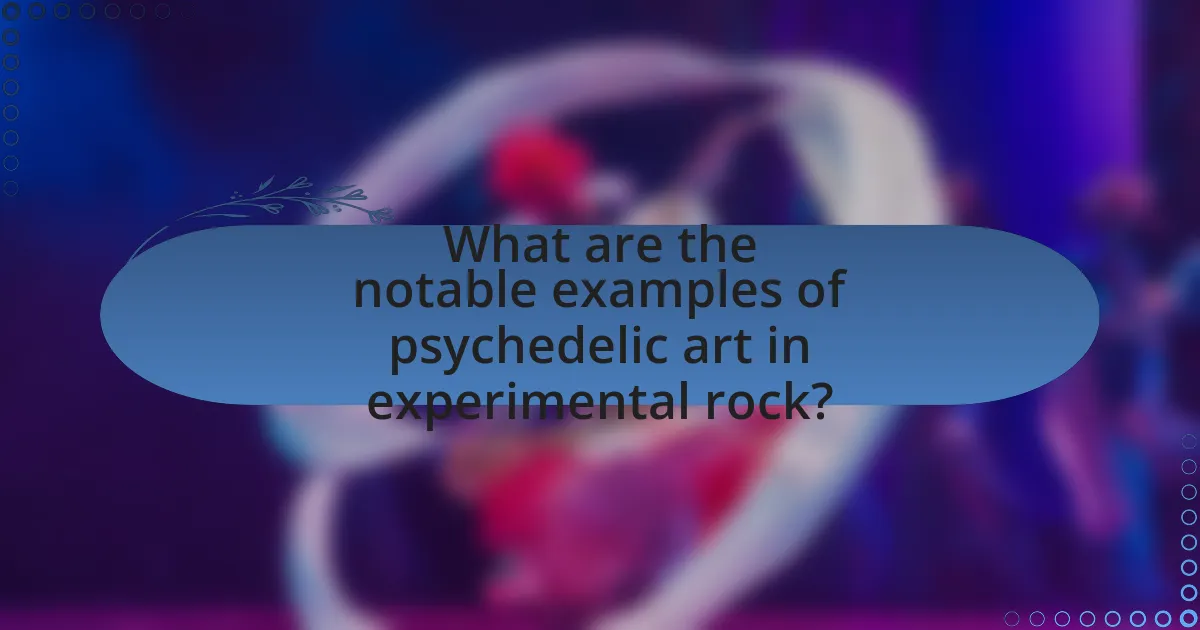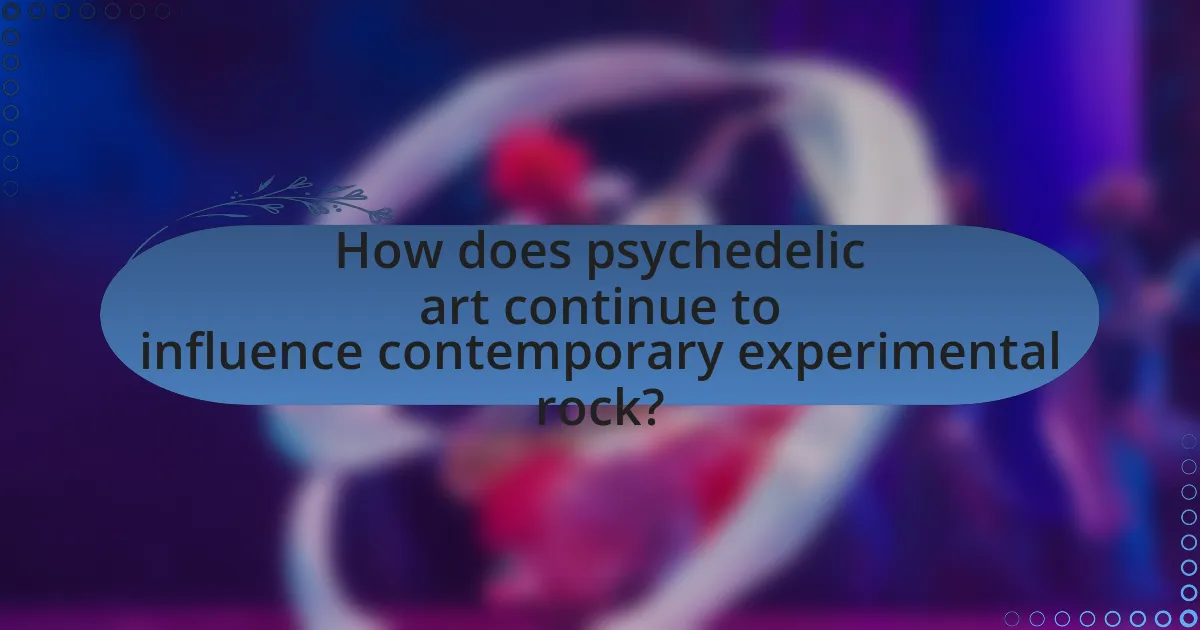The article examines the profound relationship between psychedelic art and experimental rock, highlighting how both movements emerged in the 1960s and influenced each other through their shared exploration of altered states of consciousness. It discusses the impact of psychedelic art on the visual aesthetics and thematic content of experimental rock music, with notable examples from iconic bands such as The Beatles, Pink Floyd, and The Doors. The article also explores how live performances and album cover art enhanced the listening experience, while contemporary artists continue to draw inspiration from psychedelic art, indicating its lasting influence on modern music. Additionally, it addresses the implications of this ongoing relationship for future music genres and offers practical tips for musicians to incorporate psychedelic art into their work.

What is the relationship between psychedelic art and experimental rock?
Psychedelic art and experimental rock are intrinsically linked through their shared exploration of altered states of consciousness and sensory experiences. Both movements emerged in the 1960s, with psychedelic art visually representing the mind-expanding experiences associated with psychedelic substances, while experimental rock musicians incorporated these themes into their music, often using innovative sounds and structures to evoke similar sensations. For instance, bands like Pink Floyd and The Doors utilized surreal imagery and complex compositions to create immersive experiences that mirrored the vibrant colors and abstract forms found in psychedelic art. This synergy between visual and auditory art forms contributed to a cultural movement that sought to challenge conventional perceptions and expand the boundaries of artistic expression.
How did psychedelic art influence the development of experimental rock music?
Psychedelic art significantly influenced the development of experimental rock music by shaping its visual aesthetics and thematic content. The vibrant colors, surreal imagery, and abstract forms of psychedelic art mirrored the innovative soundscapes and unconventional structures found in experimental rock. This artistic movement, which gained prominence in the 1960s, inspired bands like The Beatles and Pink Floyd to incorporate visual elements into their performances and album covers, enhancing the overall sensory experience. For instance, The Beatles’ album “Sgt. Pepper’s Lonely Hearts Club Band” featured artwork by Peter Blake that became iconic in both music and visual culture, reflecting the psychedelic ethos. Additionally, the use of light shows and multimedia presentations during concerts became a hallmark of the genre, further intertwining the realms of visual art and music.
What are the key characteristics of psychedelic art that resonate with experimental rock?
Psychedelic art is characterized by vibrant colors, surreal imagery, and intricate patterns, which resonate with experimental rock through their shared emphasis on exploration and altered states of consciousness. This visual style complements the genre’s innovative soundscapes, often incorporating unconventional structures and effects that challenge traditional music norms. The historical context of the 1960s, when both psychedelic art and experimental rock emerged, highlights their mutual influence, as seen in album covers like The Beatles’ “Sgt. Pepper’s Lonely Hearts Club Band,” which visually encapsulates the psychedelic experience and aligns with the album’s groundbreaking musical experimentation.
How did visual aesthetics shape the sound of experimental rock bands?
Visual aesthetics significantly shaped the sound of experimental rock bands by influencing their creative processes and performance styles. The integration of psychedelic art, characterized by vibrant colors and surreal imagery, inspired musicians to explore unconventional soundscapes and innovative instrumentation, leading to a departure from traditional rock norms. For instance, bands like Pink Floyd and The Velvet Underground incorporated visual elements from album covers and live performances that mirrored their sonic experimentation, resulting in a cohesive artistic expression. This synergy between visual art and music not only enhanced the auditory experience but also attracted a countercultural audience, further solidifying the connection between visual aesthetics and the evolution of experimental rock.
Why is psychedelic art considered a cultural phenomenon in the context of music?
Psychedelic art is considered a cultural phenomenon in the context of music because it visually embodies the transformative experiences associated with the psychedelic movement, particularly during the 1960s and 1970s. This art form, characterized by vibrant colors, surreal imagery, and intricate patterns, complemented the experimental rock genre, which sought to explore consciousness and transcendental experiences. Notably, album covers from bands like The Beatles and Pink Floyd featured psychedelic art, enhancing the auditory experience and creating a holistic sensory journey. The integration of this art into music culture not only influenced the aesthetics of album design but also shaped live performances, where visual projections and light shows became integral to the concert experience, reflecting the era’s countercultural ethos.
What historical events contributed to the rise of psychedelic art in music?
The rise of psychedelic art in music was significantly influenced by the counterculture movement of the 1960s, particularly the Summer of Love in 1967, which embraced alternative lifestyles and consciousness expansion. This cultural shift coincided with the popularization of hallucinogenic substances like LSD, which artists and musicians used to explore new creative dimensions. The Beatles’ album “Sgt. Pepper’s Lonely Hearts Club Band,” released in 1967, exemplified this fusion of music and psychedelic art, featuring vibrant cover art and experimental sounds that reflected the era’s ethos. Additionally, the San Francisco music scene, with bands like the Grateful Dead and Jefferson Airplane, played a crucial role in integrating visual art with live performances, further solidifying the connection between psychedelic experiences and musical expression.
How did the counterculture movement impact the relationship between art and music?
The counterculture movement significantly transformed the relationship between art and music by fostering a collaborative environment where both forms of expression influenced each other. This synergy was particularly evident in the 1960s, as artists and musicians sought to challenge societal norms and explore new creative territories. For instance, psychedelic art, characterized by vibrant colors and surreal imagery, became closely associated with the experimental rock music of bands like The Grateful Dead and Jefferson Airplane, enhancing the overall sensory experience of live performances. The use of visual art in album covers and concert posters not only reflected the themes of the music but also created a unified cultural aesthetic that resonated with the ideals of the counterculture, such as peace, love, and rebellion against the establishment. This integration of art and music during the counterculture era laid the groundwork for future artistic collaborations, demonstrating how each medium could amplify the messages and emotions conveyed by the other.

What are the notable examples of psychedelic art in experimental rock?
Notable examples of psychedelic art in experimental rock include the album covers and visual aesthetics of bands like Pink Floyd, The Beatles, and The Doors. Pink Floyd’s “The Dark Side of the Moon” features a prism design that symbolizes the spectrum of light, reflecting the band’s exploration of consciousness and perception. The Beatles’ “Sgt. Pepper’s Lonely Hearts Club Band” cover, designed by Peter Blake and Jann Haworth, showcases a vibrant collage of figures and colors, embodying the psychedelic culture of the 1960s. The Doors’ album “Strange Days” includes surreal imagery that complements their experimental sound, emphasizing themes of altered states and existential exploration. These examples illustrate how psychedelic art visually represents the innovative and boundary-pushing nature of experimental rock music.
Which bands are most associated with psychedelic art in their music?
The bands most associated with psychedelic art in their music include The Beatles, Pink Floyd, and The Doors. The Beatles incorporated psychedelic art in their album “Sgt. Pepper’s Lonely Hearts Club Band,” which featured vibrant cover art and experimental sounds that defined the genre. Pink Floyd’s “The Dark Side of the Moon” is renowned for its surreal artwork and innovative soundscapes, reflecting the psychedelic experience. The Doors, with their song “The End,” utilized poetic lyrics and atmospheric instrumentation, often accompanied by striking visual art in their album covers. These bands exemplify the fusion of music and psychedelic art, influencing the experimental rock genre significantly.
What specific albums showcase the integration of psychedelic art and experimental rock?
Specific albums that showcase the integration of psychedelic art and experimental rock include “The Piper at the Gates of Dawn” by Pink Floyd, “Sgt. Pepper’s Lonely Hearts Club Band” by The Beatles, and “In the Court of the Crimson King” by King Crimson. “The Piper at the Gates of Dawn,” released in 1967, features surreal cover art by design group Hipgnosis and incorporates innovative soundscapes that define early psychedelic rock. “Sgt. Pepper’s Lonely Hearts Club Band,” also from 1967, is renowned for its vibrant cover art by Peter Blake and its experimental approach to music production, blending various genres and sound effects. “In the Court of the Crimson King,” released in 1969, showcases a striking cover by Barry Godber and is pivotal in the development of progressive rock, merging complex musical structures with psychedelic influences. These albums exemplify the fusion of visual and auditory experimentation characteristic of the psychedelic rock movement.
How did album cover art enhance the listening experience of experimental rock?
Album cover art significantly enhanced the listening experience of experimental rock by visually representing the music’s abstract and often surreal themes. This visual representation allowed listeners to engage with the music on a deeper level, as the artwork often reflected the experimental nature of the sound, creating a cohesive artistic experience. For instance, iconic covers like Pink Floyd’s “The Dark Side of the Moon” utilized vibrant colors and geometric designs that mirrored the album’s exploration of complex themes such as time and mental health, thereby enriching the listener’s emotional and intellectual engagement with the music. Additionally, the use of psychedelic art styles, characterized by vivid colors and intricate patterns, aligned with the auditory experimentation of the genre, making the album cover an integral part of the overall artistic expression.
What role did live performances play in merging psychedelic art with experimental rock?
Live performances were crucial in merging psychedelic art with experimental rock by creating immersive experiences that combined visual and auditory elements. These performances often featured elaborate light shows, projections, and surreal stage designs that reflected the themes of psychedelic art, enhancing the overall sensory experience for the audience. For instance, bands like The Grateful Dead and Pink Floyd utilized innovative visual techniques during their concerts, which not only captivated audiences but also reinforced the experimental nature of their music. This synergy between live visuals and sound helped to establish a cultural movement where the boundaries between music and art blurred, fostering a unique artistic expression that defined the era.
How did visual projections and stage design contribute to the overall experience?
Visual projections and stage design significantly enhanced the overall experience of experimental rock performances by creating immersive environments that engaged the audience’s senses. These elements transformed traditional concert settings into dynamic visual landscapes, often synchronized with the music to evoke emotional responses. For instance, during the 1960s, bands like The Grateful Dead utilized elaborate light shows and projections that complemented their sound, fostering a deeper connection between the audience and the performance. This integration of visual art not only captivated viewers but also reflected the psychedelic themes prevalent in the music, reinforcing the cultural movement of the time.
What are some iconic live performances that exemplify this fusion?
Iconic live performances that exemplify the fusion of psychedelic art and experimental rock include Pink Floyd’s “The Wall” concert in 1980, which featured elaborate visual effects and a narrative structure that mirrored the themes of their music. Another significant performance is The Grateful Dead’s live shows during the 1970s, known for their improvisational style and vibrant light shows that created a psychedelic atmosphere. Additionally, Jimi Hendrix’s performance at the Monterey Pop Festival in 1967, where he famously set his guitar on fire, showcased the intersection of visual spectacle and experimental sound. These performances are historically recognized for their innovative integration of visual art and music, influencing the evolution of the genre.

How does psychedelic art continue to influence contemporary experimental rock?
Psychedelic art continues to influence contemporary experimental rock by shaping its visual aesthetics and thematic content. This influence is evident in the use of vibrant colors, surreal imagery, and abstract forms that mirror the auditory experimentation found in the music. Bands like Tame Impala and The Flaming Lips incorporate these visual elements into their album artwork and live performances, creating an immersive experience that reflects the psychedelic ethos. Furthermore, the thematic exploration of altered states of consciousness and existential themes in lyrics aligns closely with the narratives often depicted in psychedelic art, reinforcing the connection between the two mediums.
What modern artists draw inspiration from psychedelic art in their music?
Modern artists such as Tame Impala, MGMT, and The Flaming Lips draw significant inspiration from psychedelic art in their music. Tame Impala, led by Kevin Parker, incorporates vivid, surreal soundscapes and colorful visuals reminiscent of 1960s psychedelic art, evident in albums like “Currents.” MGMT’s work, particularly in “Oracular Spectacular,” features whimsical and trippy elements that echo psychedelic aesthetics. The Flaming Lips are known for their elaborate live shows and album art that reflect psychedelic themes, as seen in “The Soft Bulletin.” These artists exemplify the ongoing influence of psychedelic art on contemporary music, blending visual and auditory experiences to create immersive artistic expressions.
How have contemporary visual artists collaborated with experimental rock musicians?
Contemporary visual artists have collaborated with experimental rock musicians by creating immersive visual experiences that enhance live performances and album aesthetics. For instance, artists like Joshua Light Show and visual collective 3D have worked with bands such as The Velvet Underground and Radiohead, respectively, to produce synchronized light shows and video projections that complement the music’s experimental nature. These collaborations often involve the integration of multimedia elements, where visual artists design album covers, stage backdrops, and music videos that reflect the psychedelic themes prevalent in the genre. This synergy not only enriches the audience’s experience but also pushes the boundaries of artistic expression within both fields, as seen in the work of artists like Yayoi Kusama, who has collaborated with musicians to create visually striking environments that resonate with the soundscapes of experimental rock.
What trends in modern psychedelic art reflect the evolution of experimental rock?
Modern psychedelic art trends, such as vibrant color palettes, surreal imagery, and intricate patterns, reflect the evolution of experimental rock by mirroring the genre’s emphasis on exploration and innovation. These artistic elements often parallel the sonic experimentation found in bands like Pink Floyd and Tame Impala, where visual aesthetics enhance the auditory experience. For instance, the use of kaleidoscopic visuals in album covers and live performances aligns with the immersive soundscapes characteristic of experimental rock, creating a cohesive sensory experience. Additionally, the resurgence of analog techniques in both art and music, such as hand-drawn illustrations and vintage film effects, highlights a shared nostalgia for the psychedelic era of the 1960s and 1970s, reinforcing the connection between the two mediums.
What are the implications of this ongoing relationship for future music genres?
The ongoing relationship between psychedelic art and experimental rock is likely to lead to the emergence of new music genres that blend visual and auditory experiences. This fusion can inspire artists to explore innovative soundscapes, incorporating elements from various genres such as electronic, ambient, and world music, thereby expanding the boundaries of musical expression. Historical examples include the influence of psychedelic art on the 1960s counterculture, which resulted in the creation of genres like acid rock and progressive rock, characterized by complex compositions and surreal themes. As artists continue to draw inspiration from psychedelic aesthetics, future music genres may increasingly prioritize immersive experiences, integrating multimedia elements and interactive performances to engage audiences on multiple sensory levels.
How might the fusion of psychedelic art and experimental rock evolve in the coming years?
The fusion of psychedelic art and experimental rock is likely to evolve through increased collaboration between visual artists and musicians, leading to immersive multimedia experiences. As technology advances, artists may utilize virtual reality and augmented reality to create interactive environments that enhance live performances, allowing audiences to engage with both sound and visuals in unprecedented ways. Historical trends indicate that the resurgence of interest in psychedelic culture, as seen in the popularity of festivals and retro aesthetics, will further drive this evolution, fostering a new generation of artists who blend these mediums. Additionally, the rise of digital platforms for music distribution and visual art sharing will facilitate broader experimentation and innovation, enabling diverse influences to shape the future of this artistic fusion.
What practical tips can musicians use to incorporate psychedelic art into their work?
Musicians can incorporate psychedelic art into their work by integrating vibrant colors, surreal imagery, and abstract designs into their album covers, promotional materials, and stage visuals. This approach enhances the auditory experience by creating a visual counterpart that resonates with the themes of experimentation and altered states often found in psychedelic rock. For instance, the use of kaleidoscopic patterns and dreamlike landscapes can evoke the same feelings as the music, as seen in iconic albums like Pink Floyd’s “The Dark Side of the Moon,” which features artwork that visually represents the album’s themes of consciousness and perception. Additionally, collaborating with visual artists who specialize in psychedelic aesthetics can lead to unique and cohesive artistic expressions that elevate both the music and its presentation.